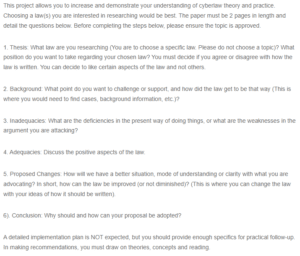Cybersecurity Act of 1984
Thesis
Homeland Security is in charge of public security for the United States of America. This includes protecting cyberspace and the flow of communication between electronic devices (White, 2017). The Counterfeit Access Device and Computer Fraud and Abuse Act of 1984 prohibits accessing computers without the owner’s consent. It was further amended in 1986 to prohibit cyberattacks such as malicious code distribution, denial of service, password trafficking, etc. (White, 2017). The Act and its amendment are proper and important in protecting the United States cyberspace, and it is the mandate of the Department of Homeland Security to enforce it.
Background
If electronic devices are used without regulation, cyberspace would be used for criminal activities. This would endanger the public that the Department of Homeland Security seeks to protect. For example, cyberattacks could be used to sabotage the government or businesses, leading to poor economic performance. The attacks could also communicate malicious messages to aid criminal activities. For example, terrorists could use cyberspace to share their itinerary. Based on this, the Cybersecurity Act 1986, which allows the Department of Homeland Security to enforce security within cyberspace, is valid (White, 2017).
Inadequacies
Encrypting data during transmission could lead to the Department of Homeland Security failing to identify malicious activities (Duhainy, 2016). This is because Homeland Security might be unable to understand the content of an encrypted message during transmission. Consequently, a security threat could be launched as an encrypted message. Therefore, an Act that allows Homeland Security to read encrypted messages that raise suspicion, especially during transmission, should be implemented (Duhainy, 2016).
Adequacies
The Cybersecurity Act of 1986 enables Homeland Security to analyze and protect cyberspace (White, 2017). This includes ensuring all cyber traffic is monitored and evaluated for safety (Duhainy, 2016). As a result, several cyberattacks are detected and stopped before damage is done. For example, the Cybersecurity Act ensures that Homeland Security only allows the transmission of approved packets to and from the United States cyberspace. It also enables the Department of Homeland Security to monitor communication within cyberspace and detect any malicious plans before they are executed. This could be identified by checking the amount of traffic flowing to and from a particular network segment to note any unusual activities. Therefore, having the 1986 Act enforced is more helpful than having none.
Proposed Changes
Changes that allow the Department of Homeland Security to read encrypted messages during transmission should be implemented in the Cybersecurity Act of 1986 (Duhainy, 2016). This would ensure that the Department of Homeland Security executes its mandate efficiently. Only encrypted messages that are flagged as suspicious would be read. Therefore, it would not raise concerns about cyberspace privacy or feel like spying on the public. Also, more specialized training on cybersecurity for officers in the Department of Homeland Security should be offered to ensure that they stay abreast with cybersecurity measures (Kessler & Ramsay, 2013).
Conclusion
The Cybersecurity Act of 1986 enables Homeland Security to protect the United States cyberspace. However, it does not allow reading encrypted messages in transit. Allowing Homeland Security to read and analyze suspicious encrypted messages in transit would enable the department to stop criminal acts before they happen. Specialized cybersecurity training would also enable the department to protect cyberspace efficiently.
References
Duhainy, B. (2016, June). Implications of Traffic Analysis to Homeland Security [Paper presentation]. The Colloquium for Information System Security Education (CISSE) Proceedings of the 20th Annual Conference, Philadelphia, PA. https://scholarworks.waldenu.edu/cgi/viewcontent.cgi?article=1018&context=sist_pubs
Kessler, G. C., & Ramsay, J. (2013). Paradigms for Cybersecurity Education in a Homeland Security Program. Journal of Homeland Security Education, 2(1), 35-44. https://core.ac.uk/download/pdf/217158212.pdf
White, R. (2017). Homeland Security and Cybersecurity. Journal of Socialomics, 6(2), 1-2. https://www.walshmedicalmedia.com/open-access/homeland-security-and-cybersecurity-2167-0358-1000201.pdf
ORDER A PLAGIARISM-FREE PAPER HERE
We’ll write everything from scratch
Question
This project allows you to increase and demonstrate your understanding of cyberlaw theory and practice. Choosing a law(s) you are interested in researching would be best. The paper must be 2 pages in length and detail the questions below. Before completing the steps below, please ensure the topic is approved.

Cybersecurity Act of 1984
1. Thesis: What law are you researching (You are to choose a specific law. Please do not choose a topic)? What position do you want to take regarding your chosen law? You must decide if you agree or disagree with how the law is written. You can decide to like certain aspects of the law and not others.
2. Background: What point do you want to challenge or support, and how did the law get to be that way (This is where you would need to find cases, background information, etc.)?
3. Inadequacies: What are the deficiencies in the present way of doing things, or what are the weaknesses in the argument you are attacking?
4. Adequacies: Discuss the positive aspects of the law.
5. Proposed Changes: How will we have a better situation, mode of understanding or clarity with what you are advocating? In short, how can the law be improved (or not diminished)? (This is where you can change the law with your ideas of how it should be written).
6). Conclusion: Why should and how can your proposal be adopted?
A detailed implementation plan is NOT expected, but you should provide enough specifics for practical follow-up. In making recommendations, you must draw on theories, concepts and reading.


